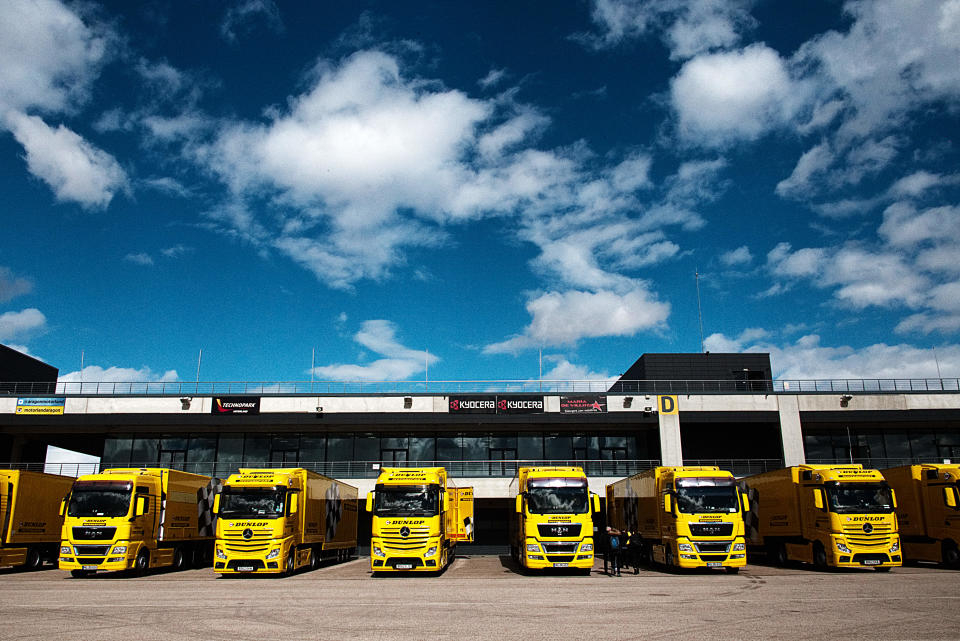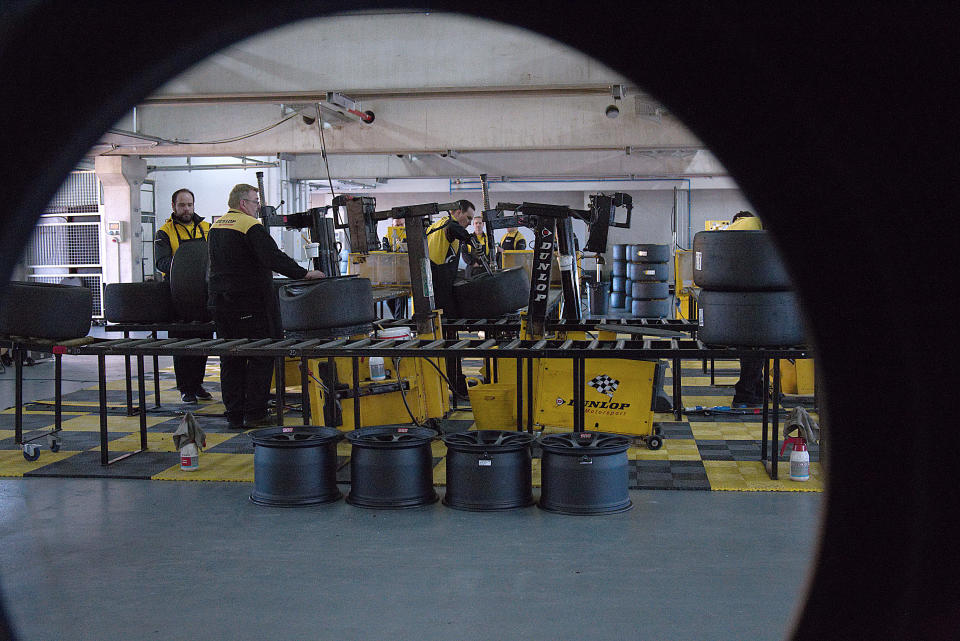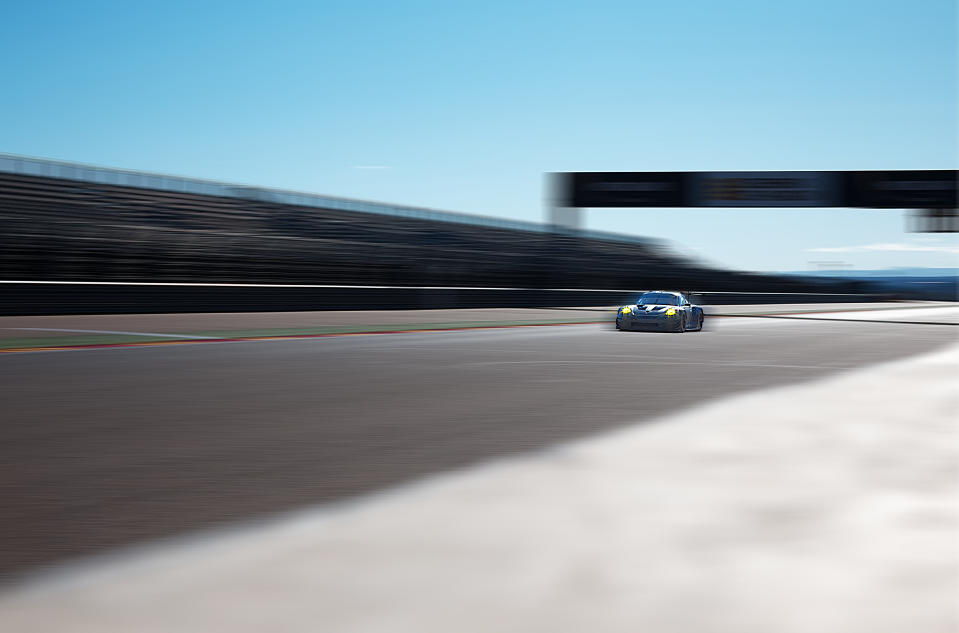The black magic of motorsport tyre testing

High in the mountains west of Barcelona, through a landscape littered with wind turbines, thirsty-looking olive groves and countless crumbling rocky outcrops, there’s black magic afoot.
Banshee wails linger in the air, and the familiar smell of tortured rubber drifts on the chill spring breeze.
I’m visiting Aragon and, although it sounds like a wizard or perhaps a dragon, in reality Aragon is a gem of a racing circuit, parked atop a sandstone moonscape a couple of hours from the Balearic coast.
READ MORE: Pre-season report – Williams
READ MORE: Pre-season report – Renault
Designed by Hermann Tilke (isn’t everything these days?) and ex-F1 driver Pedro de la Rosa, Aragon is popular both with spectators – it’s been voted best MotoGP round several times – and teams, who put its huge straight and technical curves to good use in testing as well as racing.
But I’m not here to take in racing, or watch new cars being put through their paces. No, my visit is, on the face of it, for a far more prosaic purpose – Dunlop is testing new race tyres at Aragon and I’ve been told I can snoop around to my heart’s content.
If tyre-testing sounds dull to you, I must confess I have my own doubts as I stumble sleepily on to a breakfast flight to Barcelona.
The real deal for petrol-heads

I’m in for a surprise. The car park is full of trucks – some are emblazoned with team names, a dozen are decked out in the bumblebee yellow of Dunlop and, out on track, I can see GT-class Porsches, LMP2s – some in full livery, some still wearing nothing more than the naked carbon-fibre bodywork they were born in – serious race machines that would be familiar to any fan of the Le Mans 24 Hours.
In fact, 18 Dunlop-shod teams are here for a five-day test session, which means I get up-close with competitors from the FIA World Endurance Championship, European Le Mans Series and VLN German endurance championships.
READ MORE: Pre-Season Report – Red Bull
READ MORE: Pre-Season Report – Force India
Tyre testing is, of course, a serious business – 25 cars, 3,500 tyres trucked in, almost 50 support staff – and, for a petrol-head, it’s also a fascinating business.
Every season, a company such as Dunlop has to deliver new tyres that will work for multiple teams, on different chassis, with a variety of drivers and driving styles.
It’s not just about the grippiness of the rubber either. In endurance racing, where Dunlop has had so much success – last season was the seventh consecutive year Dunlop has won at Le Mans – tyres have to be built to survive. The ability to last four, or even five, stints of the race on a single set of tyres can be the difference between success and failure.
Tyres can have a huge effect on the aerodynamic efficiency of a car, and keeping chassis at the correct ride height on straights, in corners, under varying loads, is a crucial function of any race tyre.
Factors such as rolling resistance are as important on race tyres as road tyres – tyres that help you eke out a little more distance from a given amount of fuel bring obvious advantages – and, in addition, it’s important that manufacturing and disposing of the tyres is as eco-friendly as possible.
One race, 16 cars, 3,000 tyres

Dunlop logistics expert Paul Bryant says: “This year, for the Le Mans 24 Hour race alone, we’ll be supplying tyres for 16LMP2 cars – those racers will need between 2,800 and 3,000 tyres.
“Each car is allocated 180 tyres – three slick compounds, intermediates and a full wet option. It’s a huge undertaking.”
Adding to the pressure is the fact that Dunlop prides itself on coming top in competitions where tyre supply is open – no single-manufacturer option for these guys – and rule changes have made it increasingly hard for Dunlop to keep its winning secrets a secret.
Out on track at Aragon, the tyres are being put through tests that simulate some of the more challenging conditions at circuits such as the Nordschleife and Le Mans.
When the track is configured for testing, Aragon’s turns nine to 13 map out a sweeping curve and long straight that can be taken flat out all the way, placing huge loads on the driver, the car – and the race rubber.
In the pits, I settle down to watch the data coming in – and there’s a lot of the stuff.
How do you like your tyres cooked?

One Porsche team is wading its way through the information, trying to understand how much of what it sees is down to car set-up, how much to tyre set-up and how much to the two new drivers, who are each adapting to the car and who each has his own driving style.
Adjusting rear pressures by 0.05 bar is enough to correct turn-in oversteer on one car – that’s how sensitive everything is to tyre pressures. Remember that the next time you forget to check your own car’s tyres for the third month in a row.
The tyre technicians and engineers are dealing with a moving target, literally and figuratively.
Tyres and wheels are warmed in an oven, which puts heat into the rims as well as the rubber.
A friendly member of the crew tells me: “They come out between 70C and 80C but, during running, that temperature shifts.
“You’ll find the inside of the wheel is hitting 90-95C, the outside could go down to about 65C or so – that is down to factors including camber and loading.
“You’ll also find that the tyre pressures change depending on whether the car is cornering or on a straight.”
Tyre pressure is pretty much the easiest set-up change it is possible to make, and so inevitably it’s the last thing to be tweaked, after camber and suspension settings have been decided.
But making sense of the mass of available data is an art in itself – data engineers can assess performance on a corner-by-corner basis, looking at everything from temperatures and the car’s yaw figures to acceleration and braking patterns.
The day is measured down to the nearest minute – I’m told there’s a photo opp at 10.02am when an Audi is due to pit; it’s timetabled to exit the pits exactly two minutes later. Back in Britain, when my train from Paddington goes missing for half an hour, I realise with no little nostalgia what an achievement such precision timing is.
Tyres are a team sport

A huge part of Dunlop’s success is down to how the team is handled.
Although engineers are assigned to particular racing teams, they are essentially ‘portable’. Mike McGregor, who oversees Dunlop’s pit engineers, says: “We’re very open in terms of conversation, so the lads fully understand everything that’s going on with the other teams.
“We’re massive on keeping sensitive data safe but everything feeds into our central software. If we are to understand what’s the right tyre for the right car, this is essential.
“I’ve got some guys that are really strong on data, other guys who are really strong on practical elements of the job, one of my guys used to work in the factory so he understands everything that’s going on with the tyres so much more. Each of those individuals in turn helps train the others.”
While this means that Dunlop ‘wins as a family, loses as a family’ – remember, they’re up against multiple tyre competitors for glory – it doesn’t mean that individual tyre engineers can’t win a race; far from it.
Mike says: “I’ve sat on a pit wall with a race engineer when I was doing track support myself, and we were asking, ‘Which decision do we make?’
“For example, in 2013 I was with ADR-Delta in LMP2. It was the middle of the night and we’d lost time because of a number-light issue on the car. OAK were getting away from us and it started to rain.
“We’d brought a new slick tyre with us that I knew worked in wet-weather conditions. I told the race engineer that we needed to put this slick on, and he looked at me and went, ‘Are you crazy?’
“I said, ‘Trust me Dave, I think it’s going to work, let’s try it’. Over the radio, the driver was asking what the heck I was trying to do.
“The rain calmed ever so slightly so there wasn’t a lot of standing water although it was damp. All of a sudden, the driver said, ‘The car’s come alive’.
“OAK then pitted to go from wets to intermediates, we stayed on this slick tyre, and we caught them by something like 1 minute 20 seconds. It wasn’t enough for the race result in the end but just making that call at the right time saved us from having to pit to change tyres twice.”
The flip side of that is that you’ll occasionally see engineers in tears if they think they’ve made the wrong call – and the in-house competition is understandably fierce.
Rubber – all things to all drivers

It’s difficult to understand just how many variables there are when it comes to tyre performance – not just the chemistry and physics, not just the efficiency and puncture resistance.
Each tyre has to be able to perform for several different teams, on cars with slightly different set-ups, with drivers who have markedly different styles and swap midway through a race.
Each tyre has to operate across a window of weather and temperature conditions, under heavy cornering and on long straights.
Each tyre has to cope with multiple track surfaces – Sebring, in Florida, for example, is a challenging mixture of concrete and asphalt but there are actually around 37 different surfaces to test tyres and teams.
And that’s where the tyre-black magic I mentioned at the top of the article comes in.
It’s a combination of clever science, rigorous testing and gut instinct. It’s about being able to keep your secrets secure, your own team at the top of their game, about being able to adapt to the needs of differing race teams at different circuits. It’s about racing.
If truth be told, it would be easier if it was all down to magic … much easier.

 Yahoo Sport
Yahoo Sport 






































